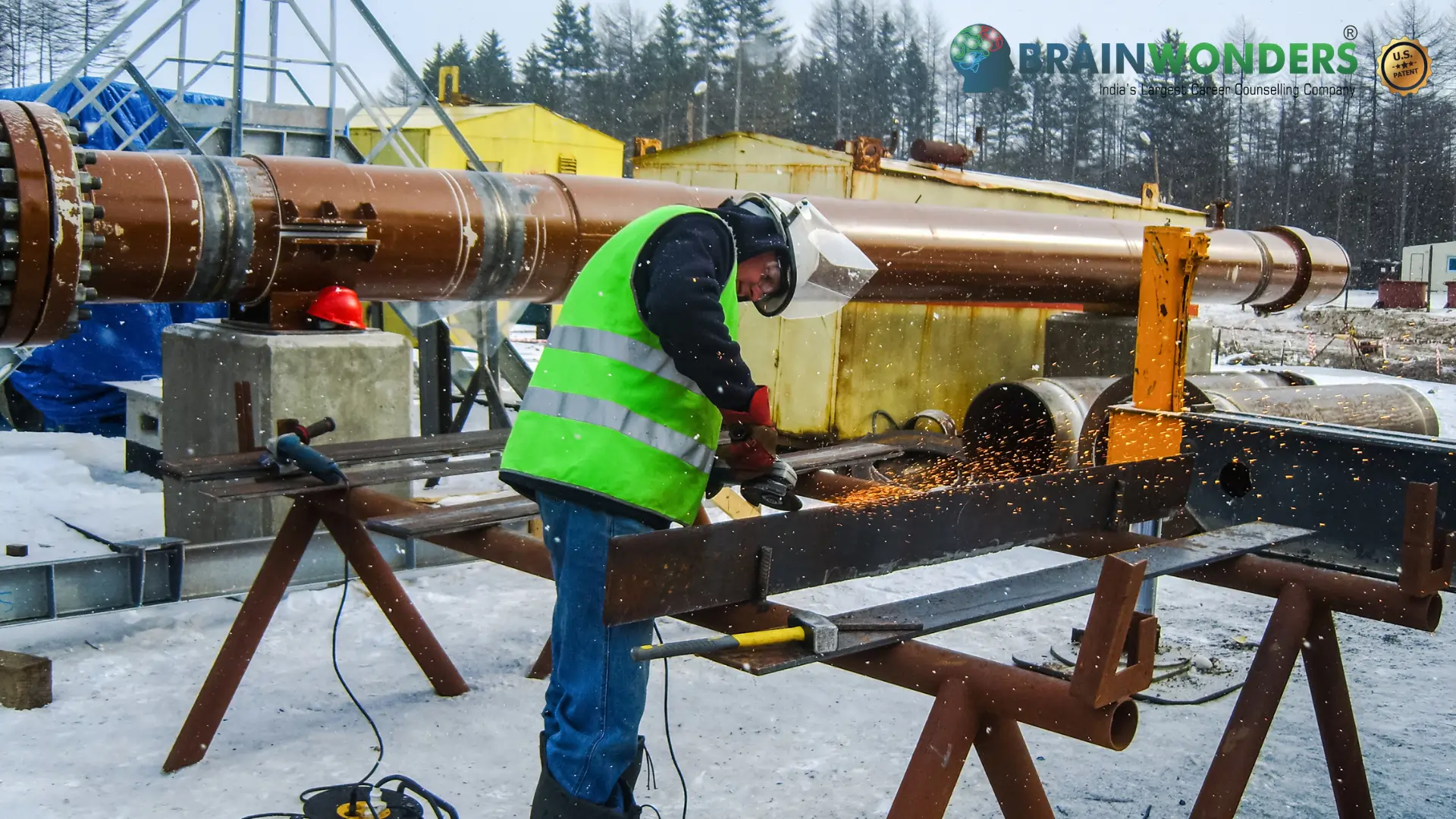How to become a Pipe Fitters and Steamfitter
Overview, Courses, Exam, Colleges, Pathways, Salary

Overview
Who is Pipe Fitters and Steamfitter ?
Pipefitters and steamfitters are skilled tradespeople specialising in installing, repairing, and maintaining piping systems that transport liquids, gases, and steam. These professionals work in various industries, including construction, manufacturing, power generation, heating, ventilation, and air conditioning (HVAC). Pipefitters and steamfitters read blueprints and technical drawings to determine the layout and configuration of pipe systems. They measure, cut, and thread pipes and then assemble and secure them using various techniques, such as welding, soldering, or brazing.
They also install fixtures, valves, and other components, ensuring proper alignment and tightness. In addition to installation, pipefitters and steamfitters are responsible for conducting inspections, troubleshooting issues, and performing repairs or maintenance tasks on existing systems. They must have a strong understanding of plumbing codes, safety regulations, and industry standards.
Physical stamina, skill, and the ability to work in confined spaces or at heights are also necessary. Pipefitters and steamfitters often work as part of a team and may collaborate with other tradespeople, such as plumbers, electricians, and HVAC technicians, to complete projects. Their work is crucial for maintaining the integrity and functionality of piping systems in various industries, ensuring the efficient transport of fluids and gases.
Typical day at work
What does Pipe Fitters and Steamfitter do?
- Reading Blueprints: Pipefitters and steamfitters study blueprints and technical drawings to understand the layout and configuration of pipe systems.
- Pipe Installation: They measure, cut, and thread pipes to the required specifications. They then assemble and secure the pipes using welding, soldering, or brazing techniques.
- Fixture and Component Installation: Pipefitters and steamfitters install fixtures, valves, and other components within the piping system to regulate flow and ensure proper functioning.
- System Maintenance: They conduct routine inspections, maintenance, and repairs on existing piping systems to identify and resolve any issues or leaks.
- Troubleshooting: Pipefitters and steamfitters use their expertise to diagnose problems within the piping system and develop practical solutions.
- Compliance with Codes and Standards: They adhere to plumbing codes, safety regulations, and industry standards to ensure the installation and maintenance of piping systems meet the required specifications.
- Collaboration: Pipefitters and steamfitters often work as part of a team, collaborating with other tradespeople, such as plumbers, electricians, and HVAC technicians, to complete projects.
- Safety: They prioritize safety by following appropriate protocols, using personal protective equipment, and ensuring proper ventilation and stability of the piping system.
Abilities and Aptitude needed
What are the skills, abilities & aptitude needed to become Pipe Fitters and Steamfitter?
- Technical Knowledge: Pipefitters and steamfitters need a strong understanding of plumbing systems, piping materials, and various pipefitting techniques. They must be familiar with different pipes, fittings, valves, and fixtures.
- Blueprint Reading: They should be proficient in reading and interpreting technical drawings, blueprints, and specifications to understand the layout and configuration of piping systems.
- Pipe Installation: Pipefitters and steamfitters should have the skills to measure, cut, thread, and assemble pipes accurately. They must be able to use appropriate tools and techniques to connect pipes securely.
- Welding and Soldering: Proficiency in welding, soldering, brazing, or other joining techniques is crucial for pipefitters and steamfitters. They must be skilled in using welding equipment and ensuring good weld quality.
- Spatial Awareness and Dexterity: These professionals need good spatial awareness and manual dexterity to work with pipes in tight or confined spaces. They must be able to handle tools and materials with precision.
- Problem-Solving: Pipefitters and steamfitters should possess problem-solving skills to troubleshoot issues, identify leaks or malfunctions, and devise practical solutions to rectify problems.
- Safety Consciousness: They must prioritize safety and follow established safety protocols, including proper handling of tools, use of personal protective equipment, and adherence to safety regulations.
- Physical Stamina: Pipe fitting and steamfitting work can involve physically demanding tasks, such as lifting heavy pipes and working in awkward positions. Physical stamina is essential to perform duties effectively.
- Teamwork and Communication: Pipefitters and steamfitters often work as part of a team, requiring practical communication skills to collaborate with other tradespeople and coordinate tasks.
Salary
Salary for Pipe Fitters and Steamfitter?
Salary for Pipe Fitters and Steamfitters is as follows :
- Minimum Monthly Salary: The minimum monthly salary for an entry-level Pipe Fitter and Steamfitter in India may range from INR 10,000 to INR 15,000 or more, depending on experience and location.
- Maximum Monthly Salary: Highly experienced and skilled Pipe Fitters and Steamfitters, especially those in senior positions or with specialized expertise, may earn a monthly salary ranging from INR 30,000 to INR 50,000 or more.
- Annual Salary: The minimum annual salary for an entry-level Pipe Fitter and Steamfitter in India could be approximately INR 1.2 lakhs to INR 2.5 lakhs annually. Highly experienced and skilled professionals may earn a maximum yearly salary ranging from INR 3 lakhs to INR 6 lakhs or more.
- Highest Paying Jobs and Scope: The highest paying jobs for Pipe Fitters and Steamfitters are often found in specialized roles like Senior Pipe Fitter, Steam System Specialist, Piping Designer, or Project Manager. These roles require extensive knowledge, experience, and expertise in piping systems and project management.The career scope for Pipe Fitters and Steamfitters is promising, as their expertise is essential in various industries that rely on efficient piping systems. With ongoing infrastructure development, construction projects, and advancements in the energy and manufacturing sectors, this field will constantly demand skilled professionals.
Pathways
How to become an Pipe Fitters and Steamfitter?
Entrance Exam
Entrance Exam for Pipe Fitters and Steamfitter ?
Courses
Which course I can pursue?
Best Colleges
Which are the best colleges to attend to become an Pipe Fitters and Steamfitter?
Industries
Which Industries are open for Pipe Fitters and Steamfitter?
- Construction: Pipefitters and steamfitters are essential in the construction industry, working on commercial, residential, and industrial projects. They install and maintain piping systems for plumbing, heating, cooling, and fire protection.
- Manufacturing: Manufacturing facilities require pipe fitters and steamfitters to install and maintain piping systems for industrial processes, such as conveying liquids, gases, or steam. This includes sectors like automotive, chemical, food and beverage, and pharmaceutical industries.
- Power Generation: Power plants, including nuclear, fossil fuel, and renewable energy facilities, employ pipe fitters and steamfitters to install and maintain piping systems for steam generation, cooling water, and fuel supply.
- Oil and Gas: In the oil and gas industry, pipe fitters and steamfitters play a vital role in the installation, maintenance, and repair of pipelines used for oil and gas transportation and processing.
- HVAC and Refrigeration: Pipefitters and steamfitters contribute to the installation and maintenance of piping systems in heating, ventilation, air conditioning (HVAC), and refrigeration systems for residential, commercial, and industrial buildings.
- Shipbuilding: Shipbuilding and marine industries require pipe fitters and steamfitters to install and maintain piping systems for various marine applications, including plumbing, fuel, and cooling systems.
- Government and Municipalities: Pipefitters and steamfitters may find employment with government agencies, municipalities, and public utilities for the installation and maintenance of piping systems in public buildings, water treatment plants, and infrastructure projects.
internship
Are there internships available for Pipe Fitters and Steamfitter?
- Apprenticeship Programs: Pipe fitting and steamfitting apprenticeship programs are widely available. These programs combine on-the-job training with classroom instruction, allowing individuals to learn the trade under the guidance of experienced professionals.
- Trade Unions and Associations: Trade unions and industry associations may offer programs or initiatives that provide practical training and work experience for aspiring pipe fitters and steamfitters. These opportunities can help individuals gain hands-on experience while building connections in the industry.
- Entry-Level Positions: Some companies or contractors may offer entry-level positions that provide on-the-job training for individuals with limited experience in pipe fitting and steamfitting. These positions allow individuals to gain practical skills and knowledge while working under the supervision of more experienced professionals.
- Informal Shadowing or Volunteer Opportunities: Contacting local pipe fitting and steamfitting companies or contractors and inquiring about shadowing or volunteer opportunities can be a way to gain exposure to the field and learn from professionals in a hands-on environment.
Career outlook
What does the future look like for Pipe Fitters and Steamfitter?
The career outlook for Pipe Fitters and Steamfitters appears promising, with steady demand in various industries. As industrial and commercial sectors continue to expand, there will be a constant need for these skilled professionals to install, repair, and maintain piping systems.
With the growth of construction projects, infrastructure development, and energy sectors, Pipe Fitters and Steamfitters can expect sustained employment opportunities. The need for upgrading and replacing aging pipelines and steam systems also contributes to job stability.
As industries focus on energy efficiency and sustainability, Pipe Fitters and Steamfitters, with expertise in green technologies, such as renewable energy systems and environmentally friendly piping solutions, will have a competitive advantage.
The aging workforce in this field also creates opportunities for new entrants to fill the gap. Training and apprenticeship programs can provide pathways for individuals seeking a career in this trade.
Overall, the future for Pipe Fitters and Steamfitters looks promising, driven by the continued growth in industries and the crucial role they play in ensuring the efficient functioning of piping and steam systems. Staying updated with the latest technologies and industry trends will be vital for professionals to thrive in this field.







